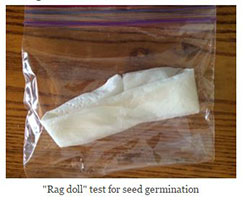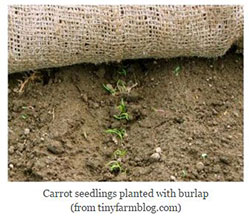Adapted by Alison O’Connor, Larimer County Extension, from the CO-Horts blog originally authored by Mary Small, Jefferson County Extension Plant Diagnostic Clinic.
Abiotic plant problems are brought on by environmental or cultural conditions. They often mimic disease, but are not caused by any living organism. They plague many gardens and landscapes, even, unfortunately, at the very beginning of the growing season.
Planting seeds is a favorite springtime rite. Once in the soil, they’re watered and watched for what seems like an interminable amount of time. And then….nothing…or spotty germination. What’s a gardener to do?

First, check the age of the seed. All seeds don’t remain viable for the same amount of time. For example, corn stays viable for around two years, yet tomato seed is viable for five years. If you are using older seed, you may first want to conduct a “rag doll” test. Take 10 seeds, place down the middle of a paper towel, roll it up and fold the sides under, so seeds don’t drop out. Moisten the paper towel and place in a sealed plastic bag on the kitchen counter. Once the time to germinate has elapsed (found on the bag of seed), open everything up and see how many seeds have germinated. If 7 out of 10 did, then you have 70% germination. You may want to sow seeds a little thicker to make up for the reduced germination rate.

Some seeds produce weak seedlings and may need help emerging through the soil especially if it crusts over easily. Carrots are a good example of this. To encourage seedlings, plant normally, but then cover the row with a piece of burlap or a board. This helps prevent soil crusting and allows the tender seedlings to germinate. When it gets close to the expected germination date, lift the covering and start checking the progress. Once most of the seedlings are up, you can remove the covering. Weak seedlings are the reason radishes are often interplanted with carrots. The stronger radish seedlings germinate first, making way for the carrots. They’re harvested in about 30 days and create even more room for the developing carrot roots, although thinning may still be needed.

Beans sometimes have germination problems. If placed in soil that’s too cool, they don’t sprout and may rot. The term “baldheading” refers to the bean seedlings that look like they have been chewed by critters. This is actually caused by mechanical injury to the growing point of the seedling. Crusty soils and damaged seeds are the likely culprits that cause baldheading.
Sweet corn planted in too cool soil, like beans, does not germinate (or germinate well) and may rot. Supersweet varieties actually need soil temperatures of at least 60 degrees F to germinate. Before planting in spring, check your soils temperature. Insert a soil thermometer several inches deep into the soil. The soil must be the desired temperature for several days before planting.
YouTube Video



